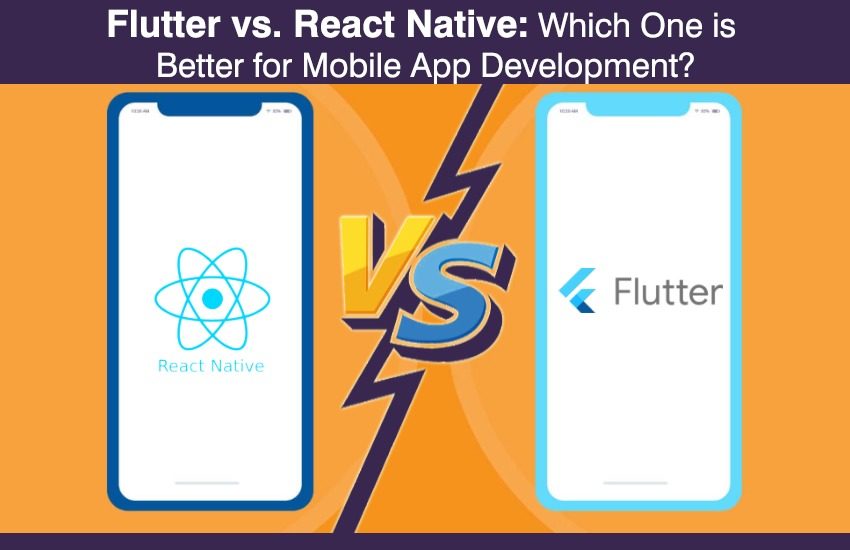Flutter vs. React Native – These two are the best cross-platform mobile app development platform used worldwide by developers. The tech giants back both of them; Flutter is created by Google while React Native is developed by Facebook, making their presence even more robust and credible.
Are you planning to invest in mobile application development, but not sure which cross-platform technology to choose? This article will clarify your concepts about Flutter vs. React Native, ultimately helping you choose the technology that fits your budget and expectations.
Flutter vs. React Native – Titans of Mobile App Development
Do you know, that there are 5 Billion + mobile phone users worldwide? As per a recent survey, 90% of mobile time is spent on mobile apps, while only 8-9% of the time is spent on the internet. These stats opens up a massive room for mobile app development and ample scope for developers.
To meet the growing need for app development, many players in the market offer native app development technology. However, Flutter vs. React Native is running way ahead in the race. The reason for their popularity is their cross-platform app development solution, open-source framework, and powerful technology. Both these frameworks also work on the concept of single code-based for different operating systems like Android, iOS, Windows, etc.
Flutter vs. React Native comes with other benefits like they are fast to code and quick bug fixing. And if we talk about their age, Flutter was launched in 2015 by Google while React Native is a bit matured as it was introduced in 2015 by Facebook. Let’s get into in-depth about these two cross-platform technologies.
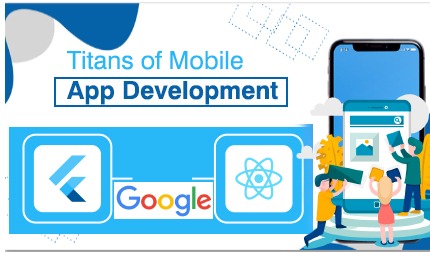
Overview of Google’s Flutter
- Flutter is a comprehensive app software development kit (SDK) that comes with a widget and tools package. With widgets, you can create an intuitive app with a great look and feel.
- Flutter is a free and open-source project supported by Google and Flutter community.
- It supports cross-platform mobile app development.
- With Flutter, developers can create visually attractive, native iOS, Android, web, and desktop applications. Developers need to learn just a single code base to design the apps.
- Flutter is based on Dart programming language, which is fast, easy to learn (for developers familiar with C and Java).
- Google launched Flutter in February 2018. Flutter 1.9 is the latest version released in September 2019.
- Popular applications built with Flutter are Google ads app, Hamilton Broadway Musical app, Alibaba, eBay, Square, JD Finance, etc.
Overview of Facebook’s React Native
- React Native uses JavaScript programming language, and it’s also an open-source project supported by Facebook.
- Developers can create apps for Android and iOS using React Native.
- React Native builds on a single codebase; hence it’s easy to learn.
- The apps that build on the React Native framework are not mobile web apps.
- React Native was first introduced in 2013 and officially launched in March 2018 on Github.
- Being more mature than Flutter gives React Native an edge with an expanded community than the previous one.
- Facebook is continually working on improving React Native with several enhancements like Lean Core, TurboModules, and React Native Fabric.
- Some popular apps that use the React Native app development framework are Instagram, Facebook, Pinterest, Tesla, Skype, Bloomberg, Wix, Fb Ads manager, Uber Ears, Walmart, etc. The list is credible as compared to that of Flutter.
Flutter Vs. React Native – Which Mobile App Development Framework is Best?
Now let’s have a comparison between these mobile app development frameworks on several aspects.
1. Which one is more popular?
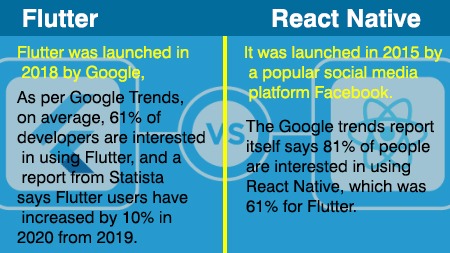
Flutter
Flutter was launched in 2018 by Google, since then it started ascending the ladder speedily. Needless to say, the gaining popularity of Flutter has reduced the market share of React Native to much extent. Besides, the intuitive mobile apps building framework of Flutter has made many developers bend towards it. As per Google Trends, on average, 61% of developers are interested in using Flutter, and a report from Statista says Flutter users have increased by 10% in 2020 from 2019.
React Native
On the other hand, React Native is five years older than Flutter, as it was launched in 2015 by a popular social media platform Facebook. Age and credibility have given the advantage to React Native in becoming highly popular than Flutter. Also, It has a more significant community than Flutter, making it a preferred mobile app development framework than the rest. In fact, the Google trends report itself says 81% of people are interested in using React Native, which was 61% for Flutter.
Conclusion
Until now, React Native carries an edge over Flutter, but the rising popularity of Flutter indicates that it will catch up with its closest competitor pretty soon. Moreover, both of these frameworks are coming up with new developments, so it’s unpredictable to say which one will be more popular.
2. Which framework uses the best programming language?
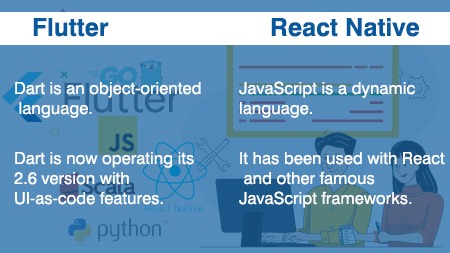
Flutter
Dart programming language is used in Flutter. Google introduced Dart in 2011, but now developers rarely use this language.
- Dart is an object-oriented language.
- Its syntax is easy to understand, especially for experienced developers who are familiar with Java and C.
- Dart is now operating its 2.6 version with UI-as-code features.
React Native
On the other hand, React native uses JavaScript programming language, one of the most popular languages amongst developers.
- JavaScript is a dynamic language.
- JavaScript holds vital significance and considered as a default language for almost every browser.
- It has been used with React and other famous JavaScript frameworks.
- With a little bit of training, a developer can build an app using JavaScript on React Native.
Conclusion
JavaScript being a default language for many browsers, is handy for many developers. Its dynamic nature is easy to adopt, and hence most developers prefer to use React Native as a preferred mobile app development platform.
3. Which has an easy installation process?
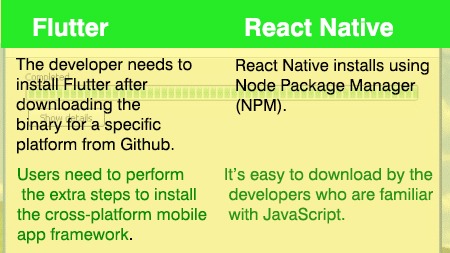
Flutter
The developer needs to install Flutter after downloading the binary for a specific platform from Github. Users need to perform the extra steps to install the cross-platform mobile app framework. However, the same can be improved once Flutter starts supporting packages like Homebrew, MacPorts, APT, etc.
React Native
React Native installs using Node Package Manager (NPM). It’s easy to download by the developers who are familiar with JavaScript. NPM installs the packages locally or globally, and the developers just need to understand where the binary is situated.
Conclusion
Installation steps for React Native are more straightforward in comparison to that for Flutter. The latter requires an extra step to download the binary from the source code and add it to the path. Besides, with React Native, there is no need for such a hassle, and you can install using package managers.
4. Whose technical architecture is better?
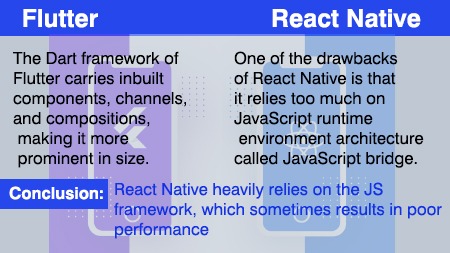
Flutter
Flutter doesn’t require a bridge between the framework and the platform’s native modules—the toolkit used the Skia C++ engine and UI frameworks such as Cupertino and Material Design. The Dart framework of Flutter carries inbuilt components, channels, and compositions, making it more prominent in size.
React Native
On the other hand, React Native is far better than the native tools for speed and productivity. One of the drawbacks of React Native is that it relies too much on JavaScript runtime environment architecture called JavaScript bridge. Moreover, React Native uses Flux architecture, which has been build by and promoted by Facebook.
Conclusion
React Native heavily relies on the JavaScript framework, which sometimes results in poor performance.
5. Performance factor – Flutter vs. React Native
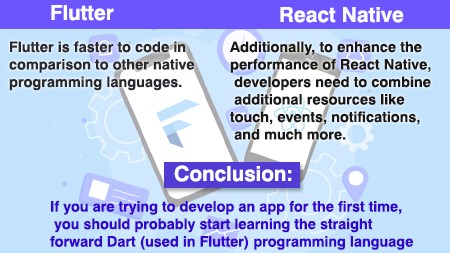
Flutter
Flutter is faster to code in comparison to other native programming languages. When it comes to app performance, the application build on Flutter is quicker and easier to code, bringing comfort to the developers.
React Native
React Native can be challenging to understand by a few developers as it requires familiarity with the JavaScript language. Additionally, to enhance the performance of React Native, developers need to combine additional resources like touch, events, notifications, and much more.
Conclusion
The developers can best evaluate the performance aspect. If you are familiar with or have hands-on knowledge of JavaScript programming language, you will be comfortable building a React Native app. If you are trying to develop an app for the first time, you should probably start learning the straightforward Dart (used in Flutter) programming language.
6. Which one is easy to set up and configure
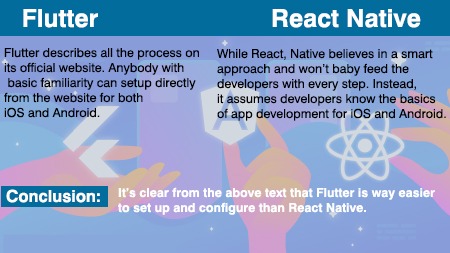
Flutter
Flutter describes all the process on its official website. Anybody with basic familiarity can setup directly from the website for both iOS and Android. Besides, Flutter gives you convenience through FlutterDoctor, a CLI tool that guides you through the setup and configuration process. It scans the local machine and tells which tools preinstall and what next needs to be installed in the system.
React Native
While React, Native believes in a smart approach and won’t baby feed the developers with every step. Instead, it assumes developers know the basics of app development for iOS and Android. The React Native document has limited Xcode command-line tools, which are enough to learn the basics. A certain level of mobile app development experience is needed to set up React Native.
Conclusion
It’s clear from the above text that Flutter is way easier to set up and configure than React Native. The latter requires expertise in mobile app development to some extent.
7. Developers productivity
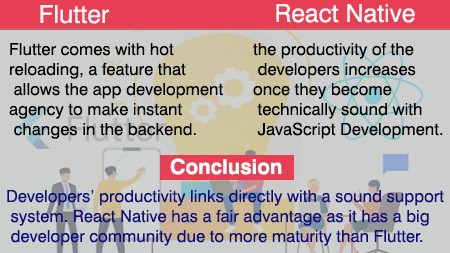
Flutter
Flutter comes with hot reloading, a feature that allows the app development agency to make instant changes in the backend. Moreover, these changes reflect quickly in the code, that too, without saving the file. Along with that, Flutter equips with an advanced software development kit that developers can use to check the internal issues instantly.
React Native
React Native also comes with a hot reloading feature. However, the productivity of the developers increases once they become technically sound with JavaScript Development. Also, developers are free to choose any text editor or IDE support while working React Native.
Conclusion
Developers’ productivity links directly with a sound support system. React Native has a fair advantage as it has a big developer community due to more maturity than Flutter.
8. Release Automation Support on App Store or Play Store
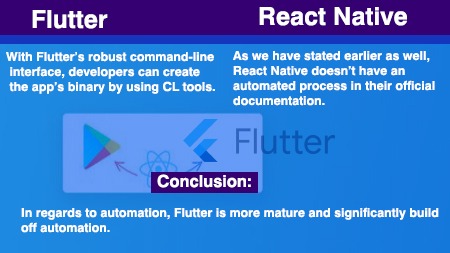
Flutter
To release the apps on Android or Apple platform can be a bit trickier. However, that problem resolves with Flutter mobile app development framework. With Flutter’s robust command-line interface, developers can create the app’s binary by using CL tools. Moreover, Flutter has clear documentation on building an releasing an app on the Play Store or App Store.
React Native
As we have stated earlier as well, React Native doesn’t have an automated process in their official documentation. Instead, they have the manual method to deploy the native apps to the App Store or Play Store.
Conclusion
In regards to automation, Flutter is more mature and significantly build off automation.
Final Verdict on Flutter Vs. React Native
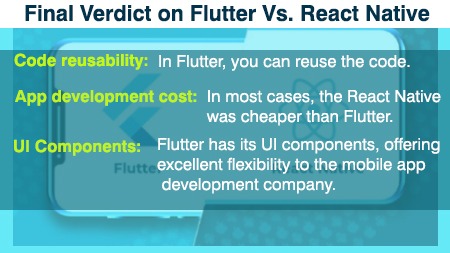
Are you still in a dilemma that you should choose a React Native developer or Flutter? We would suggest that you should not look for a winner here. Instead, look for a feasible solution that fits your business. Let’s have a quick look at the following criteria to help you reach a conclusive decision.
- Code reusability: In Flutter, you can reuse the code. Instead, code reusability is much faster, more comfortable, and flexible due to Flutter’s widget and high-performance rendering engine.
- App development cost: In most cases, the React Native was cheaper than Flutter. However, the price perspective depends on several factors. Consult the development team to get the best price quotes.
- UI Components: Flutter has its UI components, offering excellent flexibility to the mobile app development company. Also, Flutter allows the developers to use a single codebase to run it on multiple platforms like iOS or Android. While in React Native, developers need to look for third-party libraries to run apps on multiple libraries.
The Bottom Line
This unbiased article was prepared after several trials & tests on React Native and Flutter cross-platform frameworks. Both of them have some pros and cons, like many native applications. However, Flutter is developing faster due to its easy to learn Dart programming language; hence, it entered into a new mobile app development era much strongly than React Native. Moreover, in several aspects, React Native is still incomparable and wins hands down.
If you are still stuck between these two titans of the mobile apps development framework or need any help, you must consider contacting the Software Consulting Services based company. The experts here can help you choose the right platform that suits your business needs.
